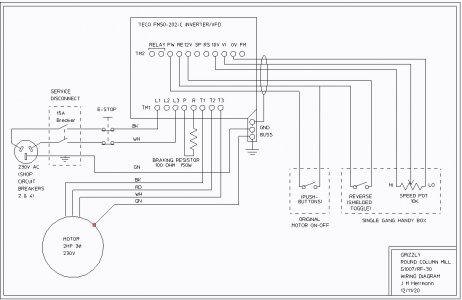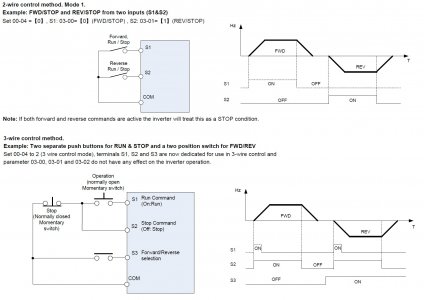- Joined
- Feb 17, 2013
- Messages
- 4,406
Here's the full motor control wiring diagram for my Griz G1007/RF-30 mill (with the Teco FM-50 VFD). The 510 would probably be wired similarly. You can set up the VFD to either use "Run forward. Run reverse" switches -or- as in my case "Run, Forward/Reverse" switches. Note that I made use of the original on/off pushbuttons on the mill for the "Run" function - just rewired them to low voltage inputs to the VFD. My fourth photo above shows the original pushbuttons, with an added "safety stop" paddle to activate the "Stop" button. By the way, you should NOT place anything between the VFD and the motor.

Given that your single phase motor is 2HP, any 2HP (or even 1 1/2HP) three phase motor should work. Who knows ... to get the proper shaft size, you might even have to find a 3HP motor. You can run a 1 1/2HP motor with a 2HP VFD, but for a 3HP motor, you'd have to go to a 3HP VFD. Worst comes to worst, you can always chuck the pulley into your lathe, bore out the hole, then add a keyway. Just don't try to drill out or ream out the pulley bore. The existing keyway will cause all kinds of problems, and the hole will end up off center. I was about to do that with the pulley for my new mill, and a "real" machinist friend strongly cautioned me not to. [I don't consider myself a real machinist - just a tinkerer who also does machining ]
]
Even easier would be if the motor shaft is smaller than the pulley bore. Then it's just a matter of turning a bushing (with a slot added to clear the key). The 2HP motor I used had a 7/8" shaft. If your pulley has a 24mm bore (0.9449"), this is what you would do.

Given that your single phase motor is 2HP, any 2HP (or even 1 1/2HP) three phase motor should work. Who knows ... to get the proper shaft size, you might even have to find a 3HP motor. You can run a 1 1/2HP motor with a 2HP VFD, but for a 3HP motor, you'd have to go to a 3HP VFD. Worst comes to worst, you can always chuck the pulley into your lathe, bore out the hole, then add a keyway. Just don't try to drill out or ream out the pulley bore. The existing keyway will cause all kinds of problems, and the hole will end up off center. I was about to do that with the pulley for my new mill, and a "real" machinist friend strongly cautioned me not to. [I don't consider myself a real machinist - just a tinkerer who also does machining
Even easier would be if the motor shaft is smaller than the pulley bore. Then it's just a matter of turning a bushing (with a slot added to clear the key). The 2HP motor I used had a 7/8" shaft. If your pulley has a 24mm bore (0.9449"), this is what you would do.



